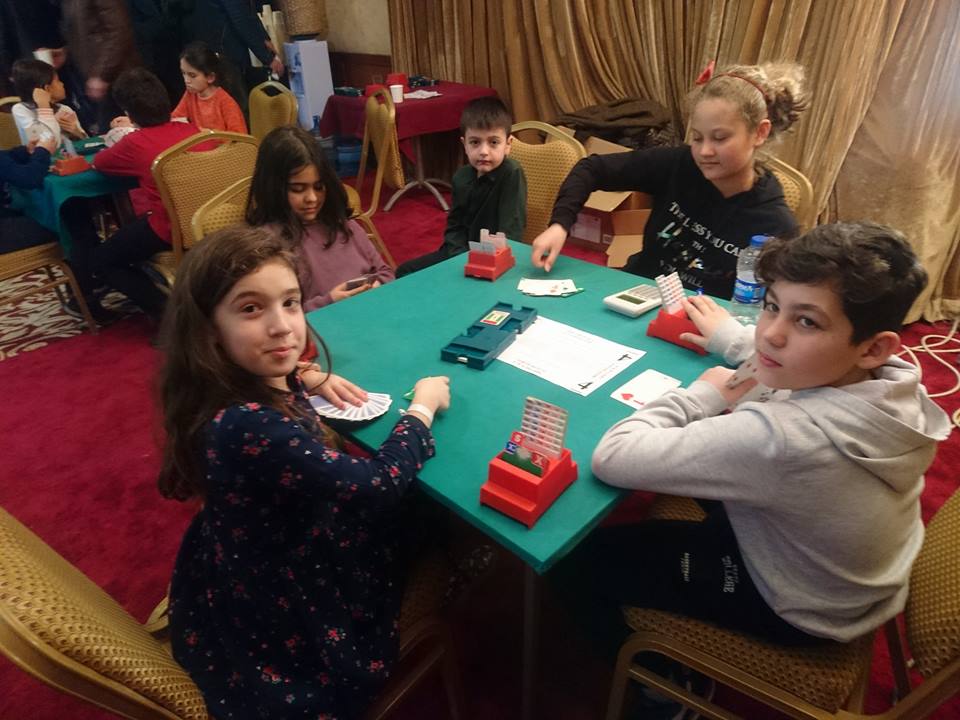Source:
BridgeWinners
Some time ago, there has been a request for a description of transfer advances. In this article I have described my preferred method after a simple overcall.
Why transfers?
When they open the bidding, they have not only partially taken our bidding room, also we have an information disadvantage compared to the opponents: They have taken the first opportunity to declare their hands.
In such a situation, it is important to be able to show length in a suit as often as possible. Transfer advances, which have been popularized by Jeff Rubens, help here. Let’s look at a basic situation:
| West |
North |
East |
South |
1 |
1 |
Pass |
? |
In standard bidding, you have to decide if you want to play 2

as forcing or non-forcing. Both meanings have proponents. Assuming your choice is non-forcing. Then you have to decide what to do with forcing hands with

. Either you can choose to bid 3

, or you make a cue-bid (2
 )
), hoping that partner’s further hand description will help you.
My preferred choice is:
- 1-over-1, e.g. (1
 ) 1
) 1 (p) 1
(p) 1 , is forcing
, is forcing
- 2-over-1, e.g. (1
 ) 1
) 1 (p) 2
(p) 2 , is non-forcing
, is non-forcing
- A new suit after a 2-level 2-overcall, e.g. (1
 ) 2
) 2 (p) 2
(p) 2 , is forcing
, is forcing
Of course your choice may differ from mine, however in some sequences you don’t have to choose! There is hardly any cost (other than memory) to play transfers starting at the opponent’s suit.
Transfers when responder passes
If advancer passes, transfers after our overcall function as follows:
| West |
North |
East |
South |
1 |
1 |
Pass |
? |
- 1
 : Forcing with
: Forcing with 
- 1NT: Natural
- 2
 : Transfer to (showing either a non-forcing 2
: Transfer to (showing either a non-forcing 2 bid or a forcing 2
bid or a forcing 2 bid)
bid)
- 2
 : Cue-bid (showing a forcing raise or a GF hand that cannot be shown otherwise)
: Cue-bid (showing a forcing raise or a GF hand that cannot be shown otherwise)
- 2
 : Simple raise
: Simple raise
The cost of this method is that your cuebid has been exchanged with the bid directly below the single raise of the overcall. This method is most effective if partner has skipped many steps in the auction to make his overcall, as here:
| West |
North |
East |
South |
1 |
2 |
Pass |
? |
- 2
 : Transfer to
: Transfer to
- 2
 : Transfer
: Transfer
- 2
 : Cue-bid
: Cue-bid
- 2NT: Natural
- 3
 : Simple raise
: Simple raise
Note that here the cue-bid has moved up two steps, allowing for two transfer bids.
However, in case of an overcall in the cheapest available suit there is unfortunately no room for transfers, as the cue-bid is already the bid directly below the simple raise:
| West |
North |
East |
South |
1 |
1 |
Pass |
? |
- 1NT: Natural
- 2
 : Non-forcing with
: Non-forcing with
- 2
 : Non-forcing with
: Non-forcing with
- 2
 : Cue-bid
: Cue-bid
- 2
 : Simple raise
: Simple raise
Further bidding after the transfer bid
After advancers makes a transfer bid, overcaller simply bids as if partner had made a non-forcing suit bid:
- Complete the transfer: I would have passed a non-forcing suit bid.
- Bid something else: I would have bid on after a non-forcing suit bid.
Particularly, with a decent hand and 3-card support for advancer, jump to 3 of partner’s suit.
As the case of accepting the transfer is the most likely outcome, let’s see what advancer’s 2nd bids show in this case:
| West |
North |
East |
South |
1 |
2 |
Pass |
2 |
| Pass |
2 |
Pass |
? |
- Pass: Non-forcing with

- 2NT: Invitational to 3NT (with 5(+)
 )
)
- 3
 : Secondary
: Secondary  support without stopper, non-forcing
support without stopper, non-forcing
- 3
 : GF asking for stopper
: GF asking for stopper
- 3
 : GF with both majors
: GF with both majors
- 3
 : Invitational, good 6+
: Invitational, good 6+
- 3NT: To play
One point to note is that the meaning of the immediate jump overcall defines the meaning of overcaller repeating his first suit:
(1

) 1

(Pass) 2

* (Pass) 2

is intermediate, if a direct 2

bid is weak, and vice versa.
When responder does not pass
If responder does not pass, one can simply play all new suit bids as non-forcing. Due to the rule-of-40 (which states that even if it looks differently, there are only 40 HCP in the deck), you won’t normally want to bid new suit forcing after an opening bid, an overcall and a voluntary response.
One situation is however notable: The bid of 2NT as response to a two-level overcall when responder has bid is no longer needed as invitational to 3NT, the natural meaning, because of the rule-of-40. This bid can now be used to show a good raise:
| West |
North |
East |
South |
1 |
2 |
2 |
? |
- Double: Both unbid suits or at least invitational w/o fit
- 2
 : Non-forcing
: Non-forcing
- 2NT: Good
 raise
raise
- 3
 : Simple
: Simple  raise
raise
- 3
 : Non-forcing
: Non-forcing
- 3
 : Asking for stopper
: Asking for stopper
- 3
 : Fit-showing jump
: Fit-showing jump
Our transfer gets doubled
All is easy if opponents pass or bid after your transfer, but what if it gets doubled? For example:
| West |
North |
East |
South |
1 |
2 |
Pass |
2 |
| X |
? |
|
|
In this case we have two more bids available. Also we can now treat both red suits as “bid suits”:
- Pass: Extra values and 4+
 .
.
- Redouble: At least invitational, no 4
 and no 3
and no 3 .
.
- 2
 : To play opposite a non-forcing 2
: To play opposite a non-forcing 2 bid.
bid.
- 2NT: Good raise to 3
 (again, 2NT is never natural when you are the fourth player to bid)
(again, 2NT is never natural when you are the fourth player to bid)
- 3
 : Intermediate with a very good
: Intermediate with a very good  suit (weak if you play int. jump overcalls)
suit (weak if you play int. jump overcalls)
- 3
 : Fit and
: Fit and  shortness
shortness
- 3
 : Fit and
: Fit and  shortness
shortness
- 3
 : Minimum hand with 3+
: Minimum hand with 3+ .
.
Transfers on a higher level
If the auction starts on a higher level, the same principle still applies:
| West |
North |
East |
South |
2 |
3 |
Pass |
? |
- 3
 : Forcing with
: Forcing with 
- 3
 : Transfer to
: Transfer to 
- 3
 : Cue-bid (asking for a stopper)
: Cue-bid (asking for a stopper)
To conclude a final warning: Be sure to agree exactly when transfers apply, otherwise all the gain of playing this convention can be lost in one single hand!
 as forcing or non-forcing. Both meanings have proponents. Assuming your choice is non-forcing. Then you have to decide what to do with forcing hands with
as forcing or non-forcing. Both meanings have proponents. Assuming your choice is non-forcing. Then you have to decide what to do with forcing hands with  . Either you can choose to bid 3
. Either you can choose to bid 3 , or you make a cue-bid (2
, or you make a cue-bid (2 ), hoping that partner’s further hand description will help you.
), hoping that partner’s further hand description will help you. ) 1
) 1 (p) 1
(p) 1 , is forcing
, is forcing ) 1
) 1 (p) 2
(p) 2 , is non-forcing
, is non-forcing ) 2
) 2 (p) 2
(p) 2 , is forcing
, is forcing : Forcing with
: Forcing with 
 : Transfer to (showing either a non-forcing 2
: Transfer to (showing either a non-forcing 2 bid or a forcing 2
bid or a forcing 2 bid)
bid) : Cue-bid (showing a forcing raise or a GF hand that cannot be shown otherwise)
: Cue-bid (showing a forcing raise or a GF hand that cannot be shown otherwise) : Simple raise
: Simple raise : Transfer to
: Transfer to
 : Transfer
: Transfer
 : Cue-bid
: Cue-bid : Simple raise
: Simple raise : Non-forcing with
: Non-forcing with
 : Non-forcing with
: Non-forcing with
 : Cue-bid
: Cue-bid : Simple raise
: Simple raise
 )
) : Secondary
: Secondary  support without stopper, non-forcing
support without stopper, non-forcing : GF asking for stopper
: GF asking for stopper : GF with both majors
: GF with both majors : Invitational, good 6+
: Invitational, good 6+
 : Non-forcing
: Non-forcing raise
raise : Simple
: Simple  raise
raise : Non-forcing
: Non-forcing : Asking for stopper
: Asking for stopper : Fit-showing jump
: Fit-showing jump .
. and no 3
and no 3 .
. : To play opposite a non-forcing 2
: To play opposite a non-forcing 2 bid.
bid. (again, 2NT is never natural when you are the fourth player to bid)
(again, 2NT is never natural when you are the fourth player to bid) : Intermediate with a very good
: Intermediate with a very good  suit (weak if you play int. jump overcalls)
suit (weak if you play int. jump overcalls) : Fit and
: Fit and  shortness
shortness : Fit and
: Fit and  shortness
shortness : Minimum hand with 3+
: Minimum hand with 3+ .
. : Forcing with
: Forcing with 
 : Transfer to
: Transfer to 
 : Cue-bid (asking for a stopper)
: Cue-bid (asking for a stopper)

























